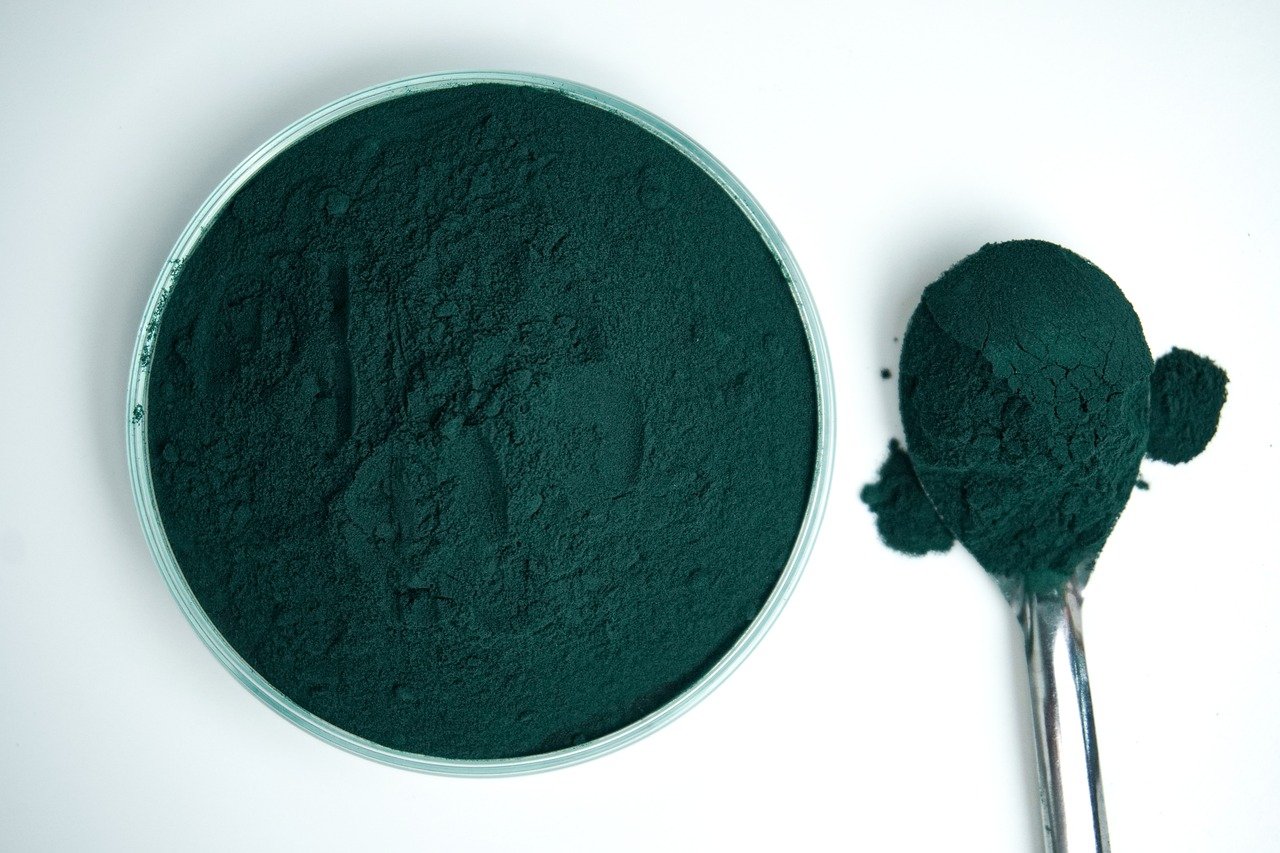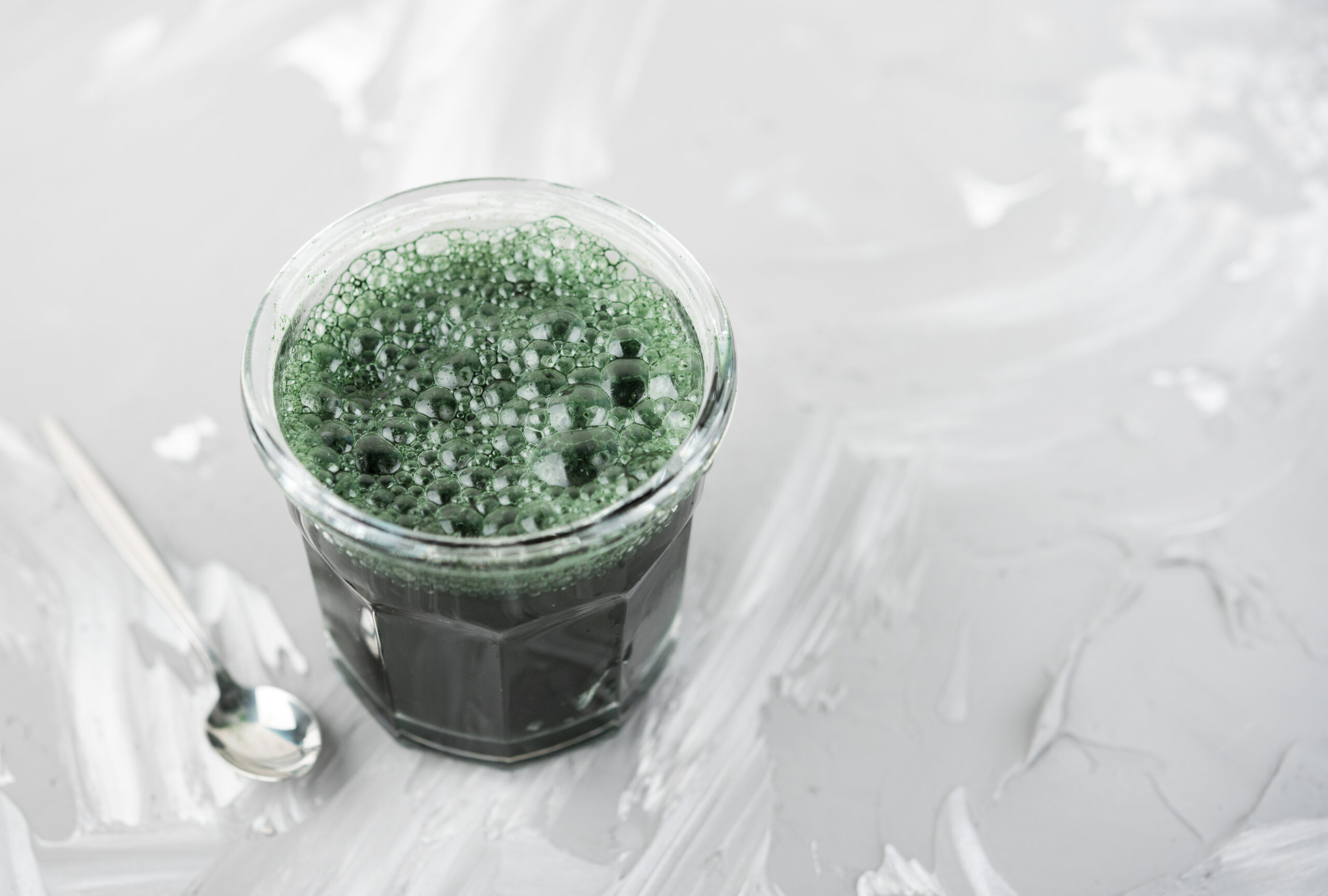Spirulina, the trade name for bacteria from the cyanobacteria class, is an autotrophic organism classified as a plant. Nowadays, they are referred to as cyanobacteria or microscopic algae. Their origin is the warm waters (fresh, sea, swamps, hot springs) of Africa, southern Asia, and South and Central America.
Where else can spirulina be found? In addition to the regions where it appears naturally, there are currently many of its crops. This algae grows practically everywhere with sufficiently high humidity. It has highly developed adaptive abilities and is the source of many health-promoting properties.
Spirulina contains so many nutrients that it is classified as a superfood—a product with a positive effect on human health. In powdered form, it has a distinct, salty taste and can be used in the kitchen as an addition to dishes.

For many years, spirulina![]() has been obtained by cultivating algae, which can grow practically everywhere in an aquatic environment with sufficiently high humidity. Algae are classified as thallus organisms, lacking developed tissues, and can self-feed through photosynthesis due to their abundant chlorophyll deposits.
has been obtained by cultivating algae, which can grow practically everywhere in an aquatic environment with sufficiently high humidity. Algae are classified as thallus organisms, lacking developed tissues, and can self-feed through photosynthesis due to their abundant chlorophyll deposits.
Among algae, cyanobacteria, also known as blue-green algae (e.g., Arthrospira platensis and Arthrospira maxima), are notable sources of spirulina. They are characterized by their greenish-blue hue and remarkable adaptability to diverse conditions.
It's challenging to determine because “superfoods![]() ” lack a clear definition. Spirulina is often marketed as a dietary supplement, typically in capsule or tablet form, which should be evaluated as such rather than as a food. In powdered form, it is treated as food. The two forms of spirulina available on the market should be analyzed separately—they differ in content, dose, and degree of absorption, and therefore, they may also differ in their effects.
” lack a clear definition. Spirulina is often marketed as a dietary supplement, typically in capsule or tablet form, which should be evaluated as such rather than as a food. In powdered form, it is treated as food. The two forms of spirulina available on the market should be analyzed separately—they differ in content, dose, and degree of absorption, and therefore, they may also differ in their effects.
Despite its standard use, “superfoods” is rather a marketing term. It is used mainly in reference to food (not enriched) with naturally high nutritional density (high content of various nutrients), demonstrating health benefits, having scientifically documented benefits in preventing the risk of developing civilization diseases, and not increasing the consumption of salt and other ingredients with a documented adverse effect on health. This food should also be easily accessible and inexpensive.
Popular superfoods largely resemble so-called functional food, i.e., food with a proven, based on representative scientific research, beneficial, supra-nutritional effect on improving health and well-being and disease prevention. It must be food consumed traditionally (not in tablets, powder, etc.) and have a demonstrated health benefit for the size of a standardly consumed portion.
Spirulina is a great source of protein. It also contains exogenous amino acids, chlorophyll, antioxidants, vitamins, and minerals.
Many scientific institutions indicate that the term “superfood” is used solely for marketing purposes to encourage consumers to buy a given food product. It is suggested that the results of credible scientific research should support their health benefits. In fact, “superfoods” have not been defined and adopted by any scientific societies, although consumers and sellers eagerly use them. It is also worth remembering that it is increasingly being pointed out that a single food does not have a massive impact on our health – the key to maintaining health and good psychophysical condition is the overall diet pattern and, in a broader sense, the entire lifestyle.
Whether spirulina is healthy probably does not need to be answered. The wealth of substances it contains determines its beneficial effect on health. The chemical composition![]() includes:
includes:
The main nutritional component of spirulina is protein![]() , which is four times more than meat of the same weight. Its energy value is about 290 kcal per 100 g.
, which is four times more than meat of the same weight. Its energy value is about 290 kcal per 100 g.
Spirulina is sometimes added to preparations with collagen and chlorophyll, a component of another alga (chlorella).

Spirulina offers a wide array of health benefits![]() owing to its rich composition. Its multifaceted effects contribute to properly functioning various bodily systems and tissues. Notable medicinal properties of spirulina encompass blood pressure regulation, mitigating the risk of heart ailments and coronary artery disease. Furthermore, its capacity to regulate cholesterol levels aids in averting heart disease and atherosclerosis. This attribute stems from its high concentration of unsaturated fatty acids – essential as the human body does not endogenously synthesize them and thus necessitates external supply.
owing to its rich composition. Its multifaceted effects contribute to properly functioning various bodily systems and tissues. Notable medicinal properties of spirulina encompass blood pressure regulation, mitigating the risk of heart ailments and coronary artery disease. Furthermore, its capacity to regulate cholesterol levels aids in averting heart disease and atherosclerosis. This attribute stems from its high concentration of unsaturated fatty acids – essential as the human body does not endogenously synthesize them and thus necessitates external supply.
Moreover, the most important medicinal properties of spirulina include:
Spirulina, in addition to its medicinal effect, also shows:
The methods of use depend primarily on the form chosen. According to the manufacturer's recommendations, the easiest way is to take spirulina in tablets.
It is worth noting that different preparations may have different substance content, which determines how many tablets should be taken daily. The daily dose![]() usually ranges from one to six tablets, three times a day (to consume about 3g of algae during the day).
usually ranges from one to six tablets, three times a day (to consume about 3g of algae during the day).
It is usually recommended to take it during or after a meal, but for tablets or capsules, it is best to read the leaflet and follow the instructions.
Spirulina on an empty stomach is recommended to stimulate the production of enzymes and support digestive processes. Due to its high protein content, it helps rebuild and regenerate muscle tissue after training. When using more than one tablet daily, it is worth splitting the doses and taking them in the morning, afternoon, and night to maintain a constant nutrient concentration.
As previously mentioned, the powder can be ingested or incorporated into meals. The recommended dosage of powdered algae typically is about 3 grams per day, depending on individual requirements. The duration of spirulina usage is not restricted, as it is a natural substance with side effects. In case of uncertainty, consulting a medical professional is advised.
Combinatory usage, which is entirely natural, can be safely used with various medications and food products. Do not combine it with immunosuppressive drugs or medicines metabolized by cytochrome P450 enzymes. If you have any doubts about combining spirulina with medications, consult your doctor.
When it comes to consuming algae with other products, there is a lot of freedom. You can mix it with water and drink it or add it to salads, vegetable and fruit juices, yogurts, buttermilk, pasta, or bread. Its taste goes well with many dishes, while for health purposes you can mix it with honey; it increases immunity, supports the fight against allergies, and supplies the body with various nutrients.
It is worth combining it with other superfoods to enhance its nutritional effect. It is often found together with the latter in dietary supplements because both are algae with a high protein and other nutrients that nourish the body.
You can get creative or use ready-made recipes when it comes to food. With its addition, it tastes great:
Spirulina is a great natural dye. Its green or blue color can significantly enhance the appearance of food.
Spirulina offers numerous benefits for the skin, complexion, and hair, making it a popular ingredient in pharmaceuticals, cooking, and cosmetics.
In well-stocked stationary and online drugstores, you can get products such as:
You can also make algae cosmetics at home. Add powdered spirulina to your favorite cream, mask, or hair conditioner. A cream suitable for application at night or as a mask will have its characteristic color due to the spirulina.

Side effects![]() are rare because the algae generally do not show allergic or irritating properties and are not dangerous to the human body. However, side effects cannot be ruled out because a lot depends on the individual reaction, which is difficult to predict. Possible side effects include:
are rare because the algae generally do not show allergic or irritating properties and are not dangerous to the human body. However, side effects cannot be ruled out because a lot depends on the individual reaction, which is difficult to predict. Possible side effects include:
Report any disturbing symptoms to a doctor immediately.
Contraindications to introducing algae into your daily diet include:
Its availability is widespread. You can find this product in:
It is best to buy from trusted suppliers to ensure a pure composition for safe use. Blue are usually much more expensive than green ones because they are less common.
In the case of natural products such as spirulina, the source of their origin is important, i.e., the quality of the cultivation, the conditions prevailing there, the course of the production process, and proper storage. Meeting high production standards is expensive, translating into the price, so when buying cheap spirulina, we can expect it will not be of the best quality.
The product composition is also important. Good spirulina should contain 100 percent algae. It can be enriched with natural additives, such as minerals or Chlorella (an alga from the green algae group).
Avoiding a product that is contaminated or has artificial additives is better. When we consume contaminated spirulina, various ailments may occur, such as abdominal pain, nausea, vomiting, dehydration, or shock. In extreme cases, it can even cause the risk of death.
When choosing spirulina, it is therefore worth using the offer of recognized and proven manufacturers.
On the other hand, spirulina in tablets is preferred by people who do not tolerate the characteristic taste and smell of algae or those who do not have time to prepare meals with the addition of spirulina powder.